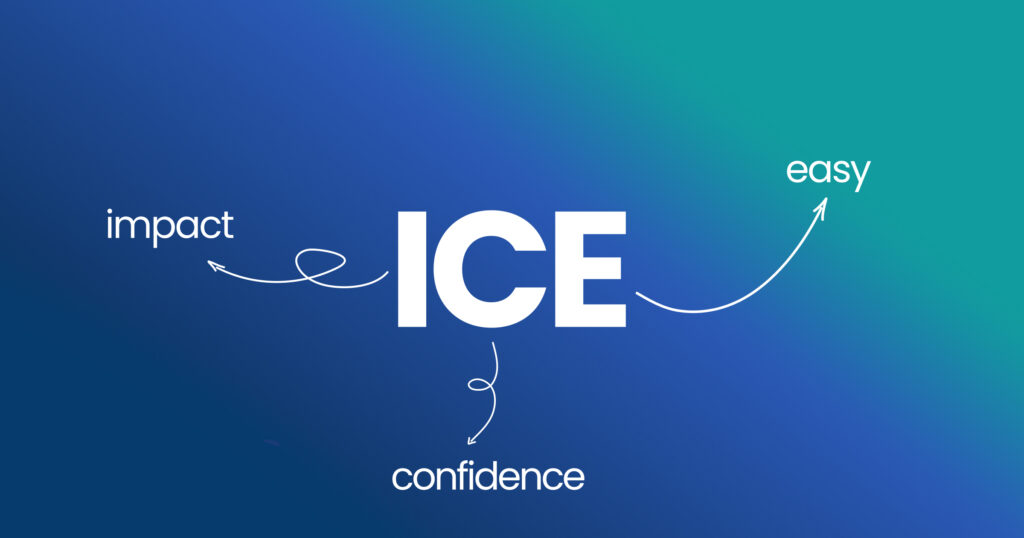Are you a business owner, startup founder, or growth marketer? You undoubtedly come across millions of big and small ideas for growing your business daily. How do you decide which experiment to focus on so you don’t waste your resources?
Imagine having a tool that can help you pinpoint the most promising marketing opportunities, guiding you toward increased engagement, conversion, and growth. Welcome ICE Scoring model- a game-changing prioritization technique making waves in growth marketing tactics.
What is ICE Scoring, you ask? How can it enhance your marketing endeavors? And why is it gaining so much attention? These are some of the questions we’ll explore in this blog post.
What is ICE Scoring?

ICE, which stands for Impact, Confidence, and Ease, is a method for marketers to prioritize and evaluate their efforts across omnichannel marketing strategies for maximum effectiveness.
Similar to A/B testing, ICE scoring is a method for evaluating marketing ideas. Yet, while A/B testing measures the performance of different versions of a single element, ICE scoring helps prioritize various initiatives based on their potential impact, confidence, and ease of execution.
If you want to know how to make things grow, we will give you valuable ideas and tips to use ICE Scoring model.
Let’s begin our adventure and discover how ICE Scoring can change how you do Growth Marketing!
Definition and Origins
ICE Scoring, in simple terms, is a powerful tool that helps marketers figure out which ideas or strategies are the best to focus on. Impact means how much of a difference the idea will make. Confidence is about how sure you are that it will work, and Ease is all about how much effort you’ll need to implement it.
The ICE scoring model, known for its remarkable speed and simplicity, owes its origins to the innovative mind of Sean Ellis. You might recognize Ellis as an initiator of growth strategies.
This method has gained widespread adoption especially in growth marketing strategies due to its effectiveness in prioritizing initiatives.
Importance in Growth Marketing
This simple yet effective scoring system is a guiding light for marketers to prioritize their strategies and experiments in organic growth marketing. While you may have countless ideas and opportunities, ICE scoring provides a structured and objective framework for decision-making.
It fosters a culture of experimentation within a growth marketing agency. It encourages marketers to think critically about their ideas and strategies, considering each endeavor’s potential rewards, feasibility, and risks.
You can also integrate ICE scoring with growth loops, which allows for a continuous feedback mechanism and helps identify marketing efforts that consistently drive exponential growth.
Who Should Use the ICE Scoring Model?

The ICE scoring method is a versatile tool tailored to benefit a diverse audience, primarily growth marketers, startup founders, and thought leaders.
- Growth marketers can harness ICE scoring to systematically evaluate and prioritize their marketing strategies.
- Startup founders can leverage ICE scoring to make informed choices about product development, marketing campaigns, and resource allocation.
- Thought leaders can get a structured approach to vetting and refining their groundbreaking ideas.
ICE scoring model empowers these professionals to make data-driven decisions, foster a culture of experimentation, and drive meaningful change in their respective domains.
Advantages of ICE Scoring
The ICE prioritization process brings many advantages. Let’s look at the key benefits of it.
1. Quick Decision-making: Imagine you’re a product manager juggling multiple feature requests. ICE scoring allows you to swiftly assess and prioritize these requests based on their potential Impact, Confidence level, and Ease of implementation.
2. Simplicity: ICE scoring means you can implement it without extensive training or specialized knowledge. This simplicity empowers teams to get started quickly and make data-driven decisions.
3. Transparency: Consider a scenario where your development team needs to decide which marketing campaign to launch next. ICE scoring demystifies the process. Team members can quickly see how priorities are established, promoting transparency and trust.
4. Relative Prioritization: ICE scoring allows you to compare initiatives or features relative to each other, ensuring you invest resources where they’ll have the most significant impact.
5. Balanced Approach: ICE scoring doesn’t solely focus on potential impact. It also considers feasibility and confidence scores. This holistic approach leads to a more balanced view of what you should prioritize.
6. Collective Consensus: Picture a situation where various stakeholders have differing opinions on project priorities. ICE scoring acts as a mediator, facilitating discussions and helping teams reach a collective consensus.
7. Quantifiability: Instead of relying on subjective judgments, ICE scoring quantifies assessments. This numerical approach makes it easier to objectively discuss, evaluate, and compare different projects or features.
8. Avoids Analysis Paralysis: Endless debates can hinder progress. ICE scoring imposes a structured evaluation and comparison process, ensuring teams are overthinking the decisions.
9. Flexibility: ICE scoring can adapt to various contexts. Its versatility makes it a valuable tool across different departments and industries.
10. Iterative Validation: ICE scoring adjusts with new data, helping companies stay agile, align resources with changing priorities, and promote ongoing learning and optimization.
Subjectivity and Limitations of ICE Scoring

While ICE scoring model offers a structured approach to prioritization, it’s essential to recognize that it’s not without subjectivity and limitations.
These aspects are essential to grasp fully, as they can significantly influence the outcomes of your decision-making process and ultimately determine the success of your endeavors.
Here, we explore these facets to ensure you understand all the nuances.
1. Personal Bias: Despite the widespread use of AI in today’s fast-changing tech world, ICE scoring relies on human judgment, and team members may bring their personal biases into the equation. These biases can skew the scores and lead to misaligned priorities.
2. Varying Interpretations: Individuals may have diverse interpretations of “high impact” or “ease of implementation.” These varying perspectives can introduce inconsistencies in the scoring process.
3. Influence of Mood and Timing: The scorer’s mood or the timing of the assessment can affect scores. For instance, end-of-quarter stress levels may impact judgment, potentially leading to different scores at different times.
4. Gut Instinct Over Data: While the ICE model emphasizes data-driven decision-making, team members might still rely on gut feelings or intuition, which can be unreliable and less objective.
5. Low-Complexity Tasks Favored: The simplicity of the ICE model may inadvertently favor “low-hanging fruit” – tasks that are easy to implement but may not yield significant long-term impact.
The Three Pillars of ICE Scoring

As you know, ICE stands for Impact, Confidence, and Ease. These three pillars serve as the foundation for making informed decisions. Let’s dive into each one:
Impact
This pillar measures the potential significance of a task or project. It asks, “How big of a difference can this make?”
How to Score: Consider the potential outcomes and benefits. Will it boost revenue? Enhance user experience? Streamline operations? The higher the score, the better.
Relevance to KPIs: Assess how closely the task aligns with your Key Performance Indicators (KPIs). Does it move the needle on your most critical metrics? If the answer is a resounding “yes,” you’re looking at a high-impact task.
Confidence
This pillar reflects how sure you are about the project’s success. Striking the right balance between data and instinct is critical here.
Role of Analytics and Gut Instinct: You’ll want to rely on data-backed insights and your gut feeling. Analytics can provide concrete evidence, while gut instinct can fill the gaps where data might be lacking.

How to Score: Rate your confidence on a scale. Are you sure it’ll succeed? Or is it more of a hopeful hunch? The higher your significant confidence score, the more likely it is to earn top marks.
Ease
This pillar assesses how straightforward implementing the task or project is. Ease looks at the practical side of things. Will it be a breeze, or require significant effort and resources?
How to Score: Consider factors like the availability of resources, the technical expertise required, and the time needed for completion. A low score suggests it might be a complex endeavor, while a high score means it’s a walk in the park.
Remember, it’s not just about one pillar; the synergy of all three guides you toward making informed and balanced choices. ICE Scoring is like having three wise advisors: Impact tells you how big a difference something can make, Confidence gauges how sure you are it’ll work, and Ease checks if it’s a walk in the park or a tough climb.
So, the next time you face a list of to-dos, consider the Impact, Confidence, and Ease – and watch your productivity soar.
Calculating the ICE Score

Now, let’s break down the steps in determining an ICE score and discuss the various scoring methodologies. We’ll also touch upon the importance of team consistency in this process.
Adding vs. Multiplying
When assessing Impact, Confidence, and Ease, you can add or multiply the scores. Adding is straightforward and gives equal weight to each factor. Multiplying, on the other hand, emphasizes the importance of a decisive score in all three areas.
Important note: Ensure your team members consistently understand and apply the scoring criteria. A unified approach ensures better decision-making.
Practice Example

Let’s explore two practical examples to understand better how ICE scoring model works in real-world scenarios. In each case, we’ll assign ICE scores to different aspects of the initiative.
Example 1: Launching a Referral Program
Imagine your task is to launch a referral program to accelerate user growth. This can effectively tap into your existing customer base and gain new users through word-of-mouth marketing.
Now, you need to ensure the referral program will leverage the enthusiasm of your current customer.
Let’s break down how you can apply ICE scoring to this initiative.
Impact: Consider the number of new customers you expect to acquire through referrals, the potential revenue increase, and the long-term impact on customer acquisition. After thorough analysis, you rate the impact 8 out of 10.
Confidence: Your team has conducted market research, surveyed existing customers, and analyzed competitor referral programs. This has given you a strong sense of how well a referral program could work. Your confidence score is 9 out of 10.
Ease: Consider the existing marketing channels, technical resources, and potential roadblocks. In this case, your team has the necessary software and expertise to implement the program efficiently. You rate the ease of implementation 7 out of 10.
Now, calculate the final ICE scores:
ICE Score = Impact (8) x Confidence (9) x Ease (7) = 504
In this example, the ICE score is 504, indicating that launching a referral program is a promising initiative worth considering, given its high score.
Example 2: A/B Testing Email Subject Lines
In this scenario, your marketing team aims to optimize email marketing by conducting A/B tests on different subject lines to boost email open rates.
Impact: Consider the percentage increase in email open rates and its direct effect on click-through rates and conversions. You assess the impact 7 out of 10.
Confidence: Your team has experience with A/B testing and has seen positive results. You’re confident in the success of this campaign, rating it 8 out of 10.
Ease: Evaluate the ease of conducting A/B tests using your email marketing software and the time and resources required. You find it relatively straightforward, so you rate the ease 8 out of 10.
Now, calculate the final ICE scores:
ICE Score = Impact (7) x Confidence (8) x Ease (8) = 448
In this example, the final ICE score is 448, suggesting that A/B testing email subject lines are a worthwhile initiative with a high potential for success.
These two examples illustrate how ICE scoring model can help you decide which initiatives to prioritize.
Advanced Techniques and Stakeholder Involvement

In our journey of mastering the ICE scoring method, let’s explore two advanced techniques that can take your decision-making process to the next level.
The “Confidence Meter”: Adding Objectivity to ICE Scoring
The human mind is a complex entity prone to various cognitive biases. In the context of ICE scoring, this can lead to inflated confidence scores, which may not accurately reflect the actual level of certainty regarding a project’s success.
The “Confidence Meter” acts as a safeguard against such biases. It requires scoring team members to provide standardized proofs or evidence to support their confidence score.
For example, if your team rates the confidence in a project’s success 9 out of 10, the “Confidence Meter” would prompt them to provide concrete data, market research results, or past performance metrics supporting this high confidence value.
Stakeholder Input
The “Confidence Meter” is not just a tool for the growth marketing team; it can also serve as a communication bridge to stakeholders, including C-level executives and investors.
By incorporating a confidence metric grounded in evidence, the outline will explain how it can create a more credible, transparent process.
In our quest to become ICE scoring experts, we’ll dive into two critical elements that can help you focus on outcomes that truly matter: customer feedback and industry trends.
The Role of Market Data
When it comes to ICE scoring, market data is your trusty compass, guiding you toward decisions that are not just good but great.
Let’s take a closer look at two significant sources of market data: customer surveys and industry trends.
Customer Surveys
Imagine you’re planning a project that aims to renovate your user interface. You might have assumptions about what your customers want, but how can you be sure? Here, customer feedback comes into play. They are like direct lines of communication with your audience.
Industry Trends
Industries are like living organisms; they evolve. You must pay attention to industry trends to keep your projects aligned with the market’s pulse. This can significantly influence your ICE scores.
By incorporating market data through customer surveys and industry trend analysis into your ICE scoring process, you’ll ensure that your decisions are grounded in real-world insights.
This enhances the accuracy of your scores and propels your projects towards outcomes that matter most to your customers.
How to Integrate ICE into Your Growth Marketing Workflow?

Now that we’ve uncovered the power of ICE scoring, it’s time to integrate it into your growth marketing workflow seamlessly.
Let’s explore how ICE becomes your trusty companion throughout ideation, prioritization, and experimentation.
Ideation, Prioritization, and Experimentation
At the heart of successful growth marketing lies a well-structured workflow. ICE scoring plays a pivotal role in this process.
Start with ideation – brainstorming creative and impactful ideas. Then, use ICE scoring for prioritization, ensuring you invest your resources wisely in projects that truly matter.
Finally, as you move into experimentation, ICE scoring helps you continuously assess the real-world impact of your efforts.
By weaving ICE scoring into your growth marketing workflow, you’re making it a part of your growth culture.
It’s a journey towards data-driven, outcome-focused success that becomes second nature to your team.
Save Your Resources, Apply ICE Scoring to Lead You to Smarter Decisions
ICE scoring isn’t just a tool; it’s a pathway to more strategic, context-aware, and effective decision-making.
In our journey, we’ve learned that ICE scoring:
- Empowers growth Marketers, startup founders, and thought leaders to make swift and informed decisions.
- Provides a transparent, quantifiable, and flexible framework.
- Encourages a balanced approach by considering impact, confidence, and ease.
- Has advanced features like the ‘Confidence Meter’ to mitigate biases.
- Benefits from market data, customer feedback, and industry trends.
- Shifts our focus to outcomes, not just outputs.
- Integrates seamlessly into growth marketing workflows.
Implementing ICE Scoring in Your Strategies

Now, it’s time to apply ICE Scoring to your everyday decision-making. Next time you’re sitting in a strategy meeting, facing a list of tasks, projects, and ideas, ICE Scoring will be your trusty compass.
It’s not just about numbers; it’s about making better, more informed choices.
So let ICE Scoring guide you to more thoughtful decisions, one step at a time.
Here’s to a future filled with data-driven success!

